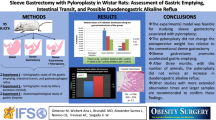Summary
The consequences of deviation of pancreatic juice and bile after gastric resection were studied in an experimental animal model in 66 rats. After hemigastrectomy and Billroth I resp. Billroth II anastomoses papilla vateri was transplanted into a deep jejunal limb in a B I and a B II group each. Absence of alkaline secretions of Papilla vateri was followed by a marked increase in acidity in the gastric remnant and connected intestine. Especially in the Billroth II operated stomach we found an increased ulcer risk under these circumstances. With additional histaminestimulation frequency of ulcer was 75% in Billroth II but only 33% in Billroth I animals. When alkaline reflux was preserved the ulcer rate ranged from 15 to 40% in all groups. These results confirmed the protective property of postresectional reflux for the integrity of anastomoses after gastric resection. The increased resistance of Billroth I anastomoses in spite of deficient luminal acid buffers could be explained by the mucus-bicarbonate-barrier of the duodenal mucosa.
Zusammenfassung
In einer tierexperimentellen Studie an 66 Ratten wurde der Einfluß der isolierten Ableitung der alkalischen Papillensekrete auf Sekretion und Morphologie des Resektionsmagens untersucht. Nach distaler Hemigastrektomie und Billroth 1 bzw. Billroth 11 Anastomose erfolgte die autologe Transplantation der Papilla Vateri in eine tiefe Jejunumschlinge in je einer B 1 und B 11 Gruppe. Es zeigte sich, daß der Verlust von Pankreas- und Gallereflux die Acidität in Restmagen und anastomosiertem Dünndarm steigert. Im Spontanverlauf sowie bei submaximaler Histaminstimulation war unter diesen Bedingungen im Billroth 11 Magen eine verstärkte Disposition zum Anastomosenulcus zu beobachten. 75% aller Billroth II Tiere mit Ableitung der Papillensekrete entwickelten ein Ulcus. In der vergleichbaren Billroth 1 Gruppe waren es 33% der Tiere. Bei erhaltenem alkalischem Reflux lag die Ulcusfrequenz uniform zwischen 15 und 40%. Die vorliegenden Ergebnisse bestätigen das protektive Prinzip des postresektionellen Refluxes für die Integrität der gastroenteralen Anastomose nach Magenresektion. Die größere Säureresistenz der Billroth 1 Anastomose auch bei insuffizienter luminärer Säurepufferung ist durch die mucosaeigene Schleim-Bicarbonat-Barriere des Duodenums zu erklären.
Similar content being viewed by others
Literatur
Alban Davies H (1985) Bile exclusion from the duodenum. Dig Dis Sci 30:954–969
Arlt G, Schumpelick V, Klöppel G (1984) Das Ulcus-Risiko des Roux-Y Magens. Langenbecks Arch Chir 362:43–52
Arlt G, Thoma G, Dombrowski T, Schumpelick V (1985) Duodenal pH-profile and gastric secretion following diversion of bile and pancreatic juice. Eur Surg Res 17 Supp 1 (Abs 69)
Dutta SK, Russell RM, Iber FL (1979) Impaired acid neutralization in the duodenum in pancreatic insufficiency. Dig Dis Sci 24:775–780
Fahrenkrug J, Schaffalitzky de Muckadell OB, Rune RJ (1978) pH threshold for release of secretion in normal subjects and in patients with duodenal ulcer and patients with chronic pancreatitis. Scand J Gastroenterol 13:177–186
Isenberg JI, Hogan DL, Thomas FJ (1986) Duodenal mucosal bicarbonate secretion in humans: A brief review. Scand J Gastroenterol 21 Suppl 125:106–109
Flemstrum G, Kivilaakso E (1983) Demonstration of a pH-gradient at the luminal surface of rat duodenum in vivo and its dependence on mucosal alkaline secretion. Gastroenterology 84:787–794
Garner A, Flemstrdm G, Allen A (1983) Gastroduodenal alkaline and mucus secretions. Scand J Gastroenterol 18 Supp 87:25–41
Grant CS, van Heerden JA (1979) Anastomotic ulceration following subtotal and total pancreatectomy. Ann Surg 190:l-5
Jaffe BM, Williams JA (1972) The use of conversion and interposition operations in the treatment of the afferent loop syndrome. Surgery 71:235–240
Junginger Th, Trapp Th, Pichlmaier H (1986) Magenresektion nach Roux und das Roux-Syndrom. Munch Med Wochenschr 128:725–729
Kennedy T, Green R (1978) Roux diversion for bile reflux following gastric surgery. Br J Surg 65:323–325
Lerut JP, Gianello PR, Otte JB, Kestens PJ (1984) Pancreaticoduodenal resection. Ann Surg 199:432–437
Lieth H v d, Gratz H, Kaiser W, Otten G (1982) Secondary jejunal interposition in the treatment of postsurgical ulcer. World Congr Gastroenterol Abstract 960, Stockholm
Marks IN, Bank S, Louw JH, Farman J (1967) Peptic ulceration and gastrointestinal bleeding in pancreatitis. Gut 8:253–259
Menguy R, Chey W (1980) Experiences with the treatment of alkaline reflux gastritis. Surgery 88:482–487
Meyer JH, Grossman MJ (1972) Release of secretin and cholecystokinin. In: Demling H (Hrsg) Gastrointestinal hormones. Thieme, Stuttgart, pp 43
Pihan G, Gallagher GT, Szabo S (1985) Biliary and pancreatic secretions influence experimental duodenal ulcer without affecting gastric secretion in the rat. Dig Dis Sci 30:240–246
Sarles H, Sahel J, Staub JL, Bourry J, Laugier R (1979) Chronic pancreatitis. In: Howat HT, Sarles H (eds) The exocrine pancreas. Saunders, London, pp 410
Schumpelick V, Arlt G, Riechert B, Klapdor R (1984) Ulkusrisiko refluxverhütender Rekonstruktion nach Magenresektion. Z Gastroenterol 22:630–643
Takeuchi K, Ohtsuki H, Okabe S (1985) Role of HCO, secretion in the etiology of duodenal ulcers induced by mepirizole in rats. Gastroenterology 86:1276
Washer GF, Gear MWL, Dowling BL, Walford-Gillison E, Royston CMS, Spencer J (1986) Duodenal diversion with vagotomy and antrectomy for severe or recurrent reflux esophagitis and stricture: An alternative to operation at the hiatus. Ann R Coll Surg Engl 68:222–226
Author information
Authors and Affiliations
Rights and permissions
About this article
Cite this article
Baumann, M., Arlt, G., Winkeltau, G. et al. Bedeutung von Pankreas— und Duodenalsekreten für die Protektion gastroenteraler Anastomosen nach Magenresektion —Eine tierexperimentelle Studie. Langenbecks Arch Chiv 373, 109–113 (1988). https://doi.org/10.1007/BF01262773
Received:
Issue Date:
DOI: https://doi.org/10.1007/BF01262773




